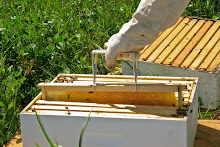I was gifted two Eurpoean honey bee (EHB) hives back before Christmas 2007 from a local Master Gardener who moved North without his bees. The hives are located at a community farm in Manatee County, Florida. Up until this point my only interaction with bees was purchasing honey at the local farmers market and my memory of watching my great uncle work his bees on the family farm as a child. I was reluctant to venture out to the hives on my own and because of this, its been 4 months since the previous owner and state bee inspector have been out to observe the hives and check on them.
Earlier this month I attended a Bee College put on by the University of Florida, hoping to gain enough knowledge and courage to make my first site visit and check on the health of the hives. Last month I purchased the minimum equipment ( suit, hat, veil, smoker, and hive tool ) to safely start my beekeeping adventure.
On Tuesday 3/25/08 my beekeeping mentor/friend and I went out to check out the hives.
Here's what I remember of our visit ...
It was a sunny, but cool, breezy day. I tried several times to get the smoker lit ... kept going out ... practice makes perfect ... and after several tries I had the smoker puffing thick cool smoke.
The 1st hive consists of a brood chamber and 3 supers. The top super had all wooden frames and only a minimal amount of comb drawn with a liitle honey. We noticed only 1 small hive beetle and a couple of mites during our inpsection of this hive. We also notice holes in the comb in 2? places where this might have been moth damage??
The 2nd super had 10 mixed wooden and plastic frames. The spacing was off and the bees had drawn out comb parallel to the fames. Getting these frames out was a bit harder, as we had to break the comb built up between the frames. This hive had most of the comb drawn and much more honey.
The 3rd super also had 10 mixed fames types. This super had fully drawn comb and was quite full of honey.
The brood chamber had a plastic queen excluder on top. Upon lifting it, we noticed a few carpenter ants and their eggs in the top corner. We checked each frame and observed eggs, larvae, both worker and drone cells. I was able to find and identify the queen on one of the last frames we checked. This hive was quite calm and we had to smoke it only slightly. The hive itself was set with the open more south than east and near a brazilian pepper tree. On a future visit I should re-orient the hive to catch the early morning sun and move it slightly by several feet to avoid shading from the pepper tree.
The 2nd hive consisted of only a brood chamber. This hive was surrounded my overgrown weeds around the hive which we removed. The hive was quite heavily populated and became agitated and more aggressive than the 1st hive. This hive had 10 frames with one or two plastic frames. We saw no eggs, but a good number of brood cells and and drones. Also we saw a queen cell that was open from the bottom, suggesting a new queen?? We were not able to locate a queen during our inspection. We noticed no small hive beetles and only 2 mites. We re-located this hive several feet away and repositioned the hive opening more to the East. This hive also had a couple of holes in the foundation. Not sure why?
Plans and tasks for next visit include ...
- Purchase super & brood wooden frames, super & brood foundations, 2 metal queen excluders.
- Add 2nd brood chamber and 1 super to 2nd hive
- What else?
We also found a nuc box with 5 old moth ridden frames inside. I took the nuc home to clean up and salvage what I could from the frames. I'll re-use the frames and get new foundation.
Overall it was an exciting and good first visit to my hives. We met the farm manager and spoke with them about having the bees on the property.
Thanks to Bethany ... you are a great mentor ... and I appreciate your help!
---------------
Note: Photos on this blog are used under a Creative Commons license
Some rights reserved.![]()




1 comment:
Hi Kurt I requeened both hives around 12/1/2007. The new Buckfast Queens were marked and they had their wings clipped. I checked the hives on 1/27/2008(had to say good bye) and Hive #1 was the more aggressive of the colonies. On your next visit you could start working #2 first and if the queen is not marked requeen. Steve
Post a Comment